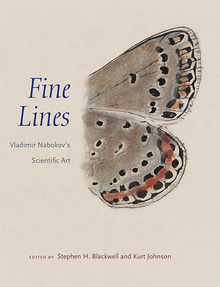Fine Lines
WARNING
You are viewing an older version of the Yalebooks website. Please visit out new website with more updated information and a better user experience: https://www.yalebooks.com
Vladimir Nabokov’s Scientific Art
Edited by Stephen H. Blackwell and Kurt Johnson
The first comprehensive, interdisciplinary accounting of Nabokov’s scientific work, its significance in his artistry, and his contribution to evolutionary theory
This landmark book is the first full appraisal of Vladimir Nabokov’s long-neglected contributions as a scientist. Although his literary achievements are renowned, until recently his scientific discoveries were ignored or dismissed by many. Nabokov created well over 1,000 technical illustrations of the anatomical structures of butterflies, seeking to understand the evolutionary diversity of small butterflies called Blues. But only lately have scientists confirmed his meticulous research and vindicated his surprising hypotheses.
This volume reproduces 154 of Nabokov’s drawings, few of which have ever been seen in public, and presents essays by ten leading scientists and Nabokov specialists. The contributors underscore the significance of Nabokov’s drawings as scientific documents, evaluate his visionary contributions to evolutionary biology and systematics, and offer insights into his unique artistic perception and creativity.
This landmark book is the first full appraisal of Vladimir Nabokov’s long-neglected contributions as a scientist. Although his literary achievements are renowned, until recently his scientific discoveries were ignored or dismissed by many. Nabokov created well over 1,000 technical illustrations of the anatomical structures of butterflies, seeking to understand the evolutionary diversity of small butterflies called Blues. But only lately have scientists confirmed his meticulous research and vindicated his surprising hypotheses.
This volume reproduces 154 of Nabokov’s drawings, few of which have ever been seen in public, and presents essays by ten leading scientists and Nabokov specialists. The contributors underscore the significance of Nabokov’s drawings as scientific documents, evaluate his visionary contributions to evolutionary biology and systematics, and offer insights into his unique artistic perception and creativity.
Stephen H. Blackwell is professor of Russian, University of Tennessee. He is the author of The Quill and the Scalpel: Nabokov’s Art and the Worlds of Science. He lives in Knoxville, TN. Kurt Johnson is author or coauthor of more than 200 journal articles on Lepidoptera and coauthor of Nabokov’s Blues: The Scientific Odyssey of a Literary Genius. He lives in Brooklyn, NY.
“This collection explains to the layman just why Nabokov’s scientific work was so successful and important. The drawings are absolutely stunning—even to someone without a scientific background they are arresting. Lepidopterists will surely want to own it, but more importantly, this will be a treasure for Nabokov fans.”—Eric Naiman, author of Nabokov, Perversely
“This is a very valuable contribution to understanding one of the great novelists of the Twentieth Century. It is a superb example of how a creative mind can combine art and science in ways that make them both greater than they would have otherwise been. A landmark book.”—Thomas E. Lovejoy, George Mason University
“What makes this volume special is not so much its attempt to merge Nabokov’s philosophy and science, but its ability to include all the relevant authors on the subject of Nabokov's dual nature.”—Nina Khrushcheva, author of Imagining Nabokov: Russia Between Art and Politics
“Fine Lines presents a welcome and rare insight into Nabokov’s obsessive attention to detail so prominent in his writing. The rich collection of his illustrations, reveal an unintended artistry born out of meticulous observation.”—Rob Kesseler, co-author of Pollen: The Hidden Sexuality of Flowers
“The wonderful drawings and remarkable essays in this book allow us to trace Nabokov's steps in many ways and on many pages. The result is a long close-up of an ideal form of curiosity.”—Michael Wood, Princeton University
“This detailed and gorgeous volume of Nabokov’s scientific achievements inspires both artistic and aesthetic appreciation for readers, historians, and scientists alike.”—Publishers Weekly
"Fine Lines clearly demonstrates the significant impact that science had on Nabokov's evolution as a writer... Few have so beautifully and meaningfully enmeshed serious scientific endeavour with artistic brilliance, visual and verbal. Fine Lines helps us to understand the phenomenon of creativity without which neither science nor true art can exist."—Vladimir Lukhtanov, Nature
“[This] book is a lovely object. . . . Even for the non-specialist, it’s impossible to thumb through Fine Lines without catching an infectious sense of punctiliousness married to passion. . . . Nabokov’s creatures are a blissful, winged confluence of earth and air, appetite and beauty.”—Brad Leithauser, Washington Post
“Fine Lines . . . reproduces a hundred and fifty-four of [Nabokov’s] illustrations, some for the first time. . . . [and] the commentary is so fully intertwined with the work that, by the end, it’s impossible to imagine one without the other. The writer and the lepidopterist really do turn out to be the same person, engaged in a single, if multifaceted, project of knowledge and description.”—Elif Batuman, New Yorker
“Fine Lines . . . showcases Nabokov’s illustrations of butterflies alongside essays exploring their relation to his literature and life. Done on index cards—the same medium he used to write his novels—the black-and-white and color drawings are exacting, elegant, and alluring.”—Steff Yotka, Vogue
“A fascinating read.”—Bob Lane, Metapsychology
“Fine Lines illustrates Nabokov’s sophisticated power of observation. It is a talent known to anyone familiar with the author’s lucid prose, which we may now see extended to his drawings and scientific inferences. . . . Above all, Fine Lines may be viewed as a book about the act of seeing.”—Matt Reimann, ArtNews
“One of [Nabokov’s] deepest passions was studying butterflies. . . . [Fine Lines] honors his dedication to the delicate creatures. The book is a collection of more than 150 of his scientific illustrations of butterflies, rivaling John James Audubon in their detail.”—Danny Lewis, Smithsonian
“One of the first works to thoroughly investigate his butterfly studies and scientific illustrations . . . Fine Lines argues for more balance between science and art in considering Nabokov’s legacy.”—Allison Meier, Hyperallergic
Selected by Nature as one of its Top 20 Books of 2016
“Nabokov routinely associated science with passion . . . It is this passion that begets Nabokov’s passionate readers who, in turn, feel a thrill of gratitude to the writer for generously sharing his private ecstasies with them . . . .”—Galya Diment, Slavic Review
“This new and magnificent work . . . brings readers to recognize with awe the breadth and depth of Nabokov’s genius.”—Robert F. Barsky, AmeriQuests
Winner of The Brian Boyd Prize, the best book of 2016 - 2018 by someone who has previously published a book predominantly on Nabokov, sponsored by the International Vladimir Nabokov Society.
ISBN: 9780300194555
Publication Date: March 22, 2016
Publication Date: March 22, 2016
336 pages, 8 x 10
75 color + 94 b/w illus.
75 color + 94 b/w illus.








